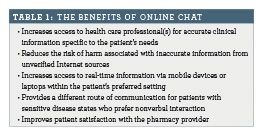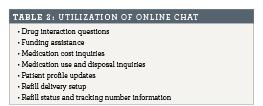Publication
Article
Specialty Pharmacy Times
Maximizing Patient Experience with the Addition of Chat Technology
Author(s):
Chat communication offers convenience and access to accurate clinical information.
THE USE OF TECHNOLOGY IS BOOMING at an unfathomable rate. As a constant stream of new technology is accepted as the norm, industries must incorporate technology to achieve success.
The health care industry is no exception to this trend. Patients are now able to utilize technology as a means to meet multiple health-related needs, including information, support, and interaction.
As part of a study by iCrossing, a digital marketing company, called How America Searches: Health and Wellness, 1084 individuals were surveyed regarding the sources that they used to find health care information: 16% spoke with a nurse, 18% spoke to pharmacists, 55% spoke with a doctor, and 59% used Internet resources.1
The high utilization of the Internet for information can be attributed to its convenience in making information accessible to patients. Although the Internet contains a vast amount of information, distinguishing between accurate and inaccurate clinical information remains a challenge.
Chatting as a Mode of Patient Contact
Diplomat is the nation’s largest independent specialty pharmacy and has constantly focused on high-touch medication management programs and clinical support for patients with chronic or serious conditions and/or those requiring treatment with high-cost specialty medications.
Some of those conditions include multiple sclerosis, cancer, chronic hepatitis C virus infection, and HIV infection. Implementation of an online chat allows for continued high-touch interaction with patients and provides a route of easy access to reliable clinical information.
A JD Power study stated that higher satisfaction was noted among those mail order pharmacies that used an online chat feature.2
Many specialty pharmacies tend to be closed-door pharmacies where, to date, the methods of communication have largely been limited to phone or e-mail. Of these, phone calls are currently the most common and often the only method of real-time interaction with a patient.
With an increased demand for communication alternatives, online chat can act as an easily accessible additional form of real-time interaction (Table 1).

Implementing the Wireless Lines of Chat
The online chat service at Diplomat was implemented as part of a postgraduate year 1 residency project. The planning and implementation phase of the project was initialized in September 2014 and involved multiple steps.
Software Selection
The software selection procedure required consideration of several factors, including marketing features, convenience, performance metrics, report tracking/generation, integrations, software support, legal and/or service level agreements, health care industry experience, and pricing.
In order to determine the most fitting software, a comparative analysis of the available software based on the above factors was completed.
Stakeholder Inputs
As the implementation site is based in a corporate setting, collaboration among multiple stakeholder departments was required. The departments included were information technology (IT), compliance, marketing, and operations.
The IT components that were integral included ensuring patient data protection, integration with the pharmacy system, billing capabilities and policies, and server encryption. Health Insurance Portability and Accountability Act (HIPAA) compliance was ensured by storing all chat transcripts at the implementation site.
Compliance was one of the most crucial components evaluated, with a focus on HIPAA and payment card industry data security standard (PCI DSS). A business associate agreement was executed to ensure vendor compliance with the specific standards and requirements.
Another component incorporated to maintain HIPAA compliance was identity confirmation, which was completed by the patient through a pre-questionnaire. All payment information shared during a chat interaction was in accordance with the PCI DSS regulations.
As a majority of the software embedment was on the pharmacy website, web development and integration processes were completed in cooperation with the marketing department. The operations department members collaborated during the implementation process and the service provision time period.
This department comprises the pharmacists and pharmacy technicians who interact directly with the patients for medication management and delivery coordination. This department focused on issues including the impact of the work flow and triage process, which concerns would be answerable via chat, and staff availability.
For quality assurance purposes, messages for routine communications in the online chat services were created and included in the software knowledge database. Figure 1 provides examples of the most commonly used messages.
Work Flow Development
The next implementation stage involved developing the online chat work flow. The work flow steps were based on the various triage requirements (Figure 2).

To begin, the patient clicks on the “Chat” button on the website (Figure 3), which leads them to the next triage point or the “contact us” web page if online chat was not available. For example, a patient who initiated a chat outside the service hours of 9 am to 8 pm Eastern Standard Time would be forwarded to the “Contact Us” page.
The “contact us” page allows the patient to leave a message and contact information for pharmacy staff to follow up. The next triage point excludes individuals who are not current patients at the pharmacy site.
The individual then completes the pre-questionnaire. This allows the pharmacy staff to confirm that the chat interaction is with the patient or the caregiver (if permission for caregiver use had been previously attained).

The pre-questionnaire also collects information regarding the patient’s diagnosis. The diagnosis is used to triage the individual to the appropriate department for questions and/or delivery setup.
Once the interaction is completed, the individual is offered a feedback questionnaire. Training All pharmacy staff selected to be part of the program received training on the software and work flow.
Training included a 1-hour didactic lecture followed by open practice sessions. The open practice sessions allowed staff hands-on practice using the software with fictional patients. Any concerns and questions that the pharmacy staff had regarding online chat were also answered during these sessions.
Service Launch
The online chat service was fully implemented for use on the pharmacy web site by February 2015, and began with promotion to patients.
Patient Is Typing…a Response
There was a positive uptake of the online chat service on deployment. Patients used the service for a wide variety of reasons (Table 2). There are patients who now use the chat feature as their preferred method of interaction with the pharmacy. According to the results of the post chat feedback survey, patient satisfaction was also positive.

One patient mentioned that they “would rather chat online than over the phone.”
Another patient mentioned that they appreciated “the convenience and personal touch of the [pharmacy staff’s] name and picture being shown.” (In order to allow for more comfortable, personable, and genuine setting, photos of the pharmacy staff were visible during the chat with a patient.)
Although initiated as a pilot, its constant utilization and benefits led to the online chat being accepted into the daily pharmacy work flow. SPT
References
- Elkin N. How America searches: health and wellness. Rx Edge Pharmacy Networks website. www.rx-edge.com/research%20pdfs/How_America_Searches_Health_and_Wellness.pdf. Published January 2008. Accessed September 2, 2015.
- Pharmacists and staff play increasingly important roles in pharmacy customer satisfaction [news release]. Westlake Village, CA: JD Power and McGraw Hill Financial; September 25, 2014. www.jdpower.com/press-releases/2014-us-pharmacy-study#sthash.BWNn8XoG.dpuf. Accessed September 2, 2015.
KANIKA KAPOOR, PHARMD, is a clinical pharmacist at Diplomat.
STEPHEN LOTT, PHARMD, CSP, is manager of utilization review and outcomes research at Diplomat.
MICHAEL CROWE, PHARMD, MBA, CSP, FMPA, is senior manager of clinical services at Diplomat.
JENNIFER HAGERMAN, PHARMD, is associate vice president of education and quality at Diplomat.
GARY RICE, RPH, MS, MBA, CSP, is senior vice president of clinical, education and human resources at Diplomat.







